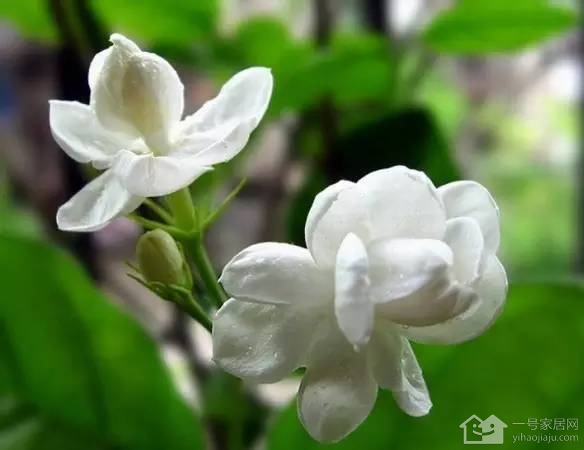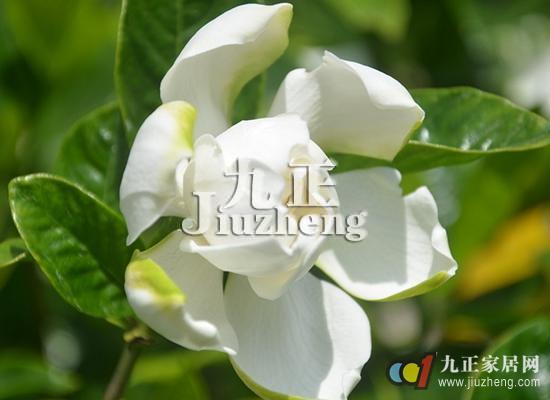How to cultivate and maintain gardenia?
Gardenia flowerpot planting should be carried out around April, the soil should choose fertile, loose and well-drained slightly acidic soil, it is best to use rotten leaf soil plus mountain mud, and add a small amount of cake fertilizer and bone powder as base fertilizer. It is better to transplant seedlings with soil balls, pour water after planting, place them in the shade for about 10 days, move to the sunny place, and transfer to normal maintenance. The main points of conservation: the first is fertilizer and water management, the second is pruning, the third is the prevention and control of diseases and insect pests.
(1) fertilizer and water management. Fertilize once a month before flowering and during the growing period, and keep the basin soil moist at ordinary times. Fertilizers combined with nitrogen and phosphorus should be applied in time for 1 or 2 times in May. Watering should be seen in wet water to prevent stagnant water after rain, so as to avoid falling leaves and buds rotting or failing to bloom. People summer appropriate to increase the amount of water, sooner or later can spray water to the leaf once, pay attention to shade, placed in a semi-shady place to maintain, avoid exposure under the scorching sun. After Frosts Descent, moved to the sunny part of the room, the room temperature above 5 ℃ can safely dormancy overwintering, and the basin soil should be kept moist and slightly dry. If the room temperature is kept above 15 ℃, it can still blossom, but the fertilizer and water must keep up.
(2) pruning. Pruning and pruning should be carried out in early spring, and the long branches should be cut off in time. From May to July, cut off the top tip, promote lateral branches and increase the number of flowers. Cut off the residual flowers after blooming and trim them again around 12 months.
(3) Prevention and control of diseases and insect pests. Excessive room temperature or poor ventilation in winter is prone to the harm of shell insects and soot disease, which can be extinguished with dimethoate 1000 times and carbendazim 500-1000 times. In order to prevent and cure the disease as soon as possible, 1000 times of chlorothalonil can be sprayed twice a month to prevent the disease.
How to prolong the florescence of Gardenia jasminoides? Key points of cultivation and maintenance of Gardenia jasminoides
At the beginning of graduation, gardenia is in full bloom, named because of its fruit like a wine glass, also known as yellow gardenia, flowering from June to August, properly maintained, blooming for as long as February. Gardenia likes a warm, moist and half-yin and half-yang environment, which is suitable for growing on fertile, loose and moist acidic loess. Therefore, the conservation of gardenia, need to do the following work.

1. Cultivation and maintenance
Gardenia should be transplanted with soil, which should be carried out in spring or plum rainy season. the soil should choose fertile, loose and well-drained acid soil, pot planting should use rotten leaf soil plus mountain mud, add a small amount of cake fertilizer and bone powder as base fertilizer, pour water through water after transplanting, put it in a cool place, and carry on normal management after slowing down seedlings.
Pruning and pruning should be carried out in early spring, cutting off the long branches in time, and cutting off the top tips from May to July to promote branching. Cut off the remnants of the flowers after they fade. Hot summer to more watering, sooner or later spray water to the leaf surface, increase humidity, pay attention to shade, do not be exposed to direct sunlight, it is best to put under the shade, or move into the indoor ventilation place.
Spring and autumn can be put in the outdoor sun, before flowering and throughout the growing period, thin fertilizer should be applied once every semimonthly. If yellow leaves are found, 0.1% ferrous sulfate can be used to sprinkle them in water and fertilizer. Late autumn moves indoors to the sunny place to overwinter.
Excessive room temperature and poor ventilation in winter are easy to breed scale insects and bituminous coal disease, which can be sprayed with carbendazim 500-1000 times liquid.
2. Reproduction and maintenance
Gardenia jasminoides can be propagated by cutting, striping, split and other methods.
(1) cutting
The survival rate of cuttage with tender wood is high. Take gardenia twigs as cuttings, 10-15 cm long, leave 2 leaves at the top and cut in half, cut off the rest, insert into the seedbed, shade and moisturize, and take root in about 20 days.
(2) ramet
Dig up the plant with soil, then cut it with a flower pry to the root, and plant it separately, put it in a cool place, and move it to the sun a week later.
(3) pressing strip
Gardenia planted in the ground often use this method. Select 2-3-year-old strong branches, pull down the ground, peel off some bark, press it into the soil, and then cover it with soil, it can take root after a month, and can be separated from the mother plant in mid-and late June, and planted in the next spring.
Varieties, cultivation and maintenance methods of Gardenia jasminoides
Gardenia, also known as Huangzhi, Shanzhi, yellow gardenia, jade lotus, etc., is an aromatic evergreen shrub of Rubiaceae. Dry branches up to 1-2 meters high, gray, branchlets green. Leaves shaped like rabbit ears, simple, opposite or tricuspidate, herbaceous, glossy, entire. The flower is solitary in the top of the branch or leaf axil, white, fragrant, Corolla high-footed dish-shaped, very similar to an ancient wine vessel-"Kui", so it is named Yuzi Flower (later called "Zhi"). The fruit is ovate and flattened, the ripening stage is October and the florescence is from June to August.
Gardenia is native to the southwest of China. At present, the main cultivated varieties and varieties are Gardenia jasminoides (also known as Gardenia jasminoides), with large leaves, large flowers, double petals and fragrance; gardenia jasminoides, plant short, flower leaflets also small, double; single sparrow tongue, leaf floret small, single, more wild. In addition, there are egg leaf gardenia and lobular gardenia and so on.
Gardenia likes warm and humid climate, good sunshine but can not withstand strong sunlight, suitable for growing in loose and fertile, well-drained, light clayey acidic soil, is a typical acidic flower. The pot soil should be prepared with 40% garden soil, 15% coarse sand, 30% stable fertilizer soil and 15% rotten leaf soil.
Gardenia seedlings should pay attention to watering, keep the basin soil moist, and frequently apply rotten and thin fertilizer. It is better to water with Rain Water or fermented rice water. If 0.2% ferrous sulfate water or alum fertilizer water is irrigated every 10-15 days (the two can be used alternately), it can prevent the soil from becoming alkaline, at the same time, it can supplement iron for the soil and prevent gardenia leaves from yellowing. In summer, water is sprayed to the leaves once in the morning and evening every day to increase air humidity. Potted gardenia is only watered after blooming in August, and the amount of water is controlled. Cold Dew moved into the room and placed it in the sunny place. Watering is strictly controlled in winter, but clear water is often sprayed with foliage.
When the vigorous growth period of Gardenia jasminoides is about to pass from May to July every year, pruning the plant, removing the top tip, promoting branch germination, and making the plant shape beautiful and blossom more in the future.
- Prev

What are the main diseases and insect pests of jasmine? How to prevent and cure?
The main diseases of jasmine are white silk disease, purple striped feather disease, branch blight, insect pests are shell insects, stem borer, red spider, flower bud borer, jasmine leaf borer and so on. The prevention and control methods are as follows: 1. White silk disease (1) the disease is easy to occur under the condition of high temperature and high humidity, so the garden with good ventilation and good drainage should be selected and drainage should be paid attention to in the rainy season.
- Next

How to breed gardenia?
Gardenia jasminoides can be propagated by sowing, cutting, striping, split, grafting and other methods. Cuttings, striping and ramet propagation are commonly used. The main results are as follows: (1) Hardwood cutting: hardwood cuttings are used to propagate after plant dormancy in autumn. Cut the long mature branches of 10~12cm as cuttings, leaving the top three leaves
Related
- Fuxing push coffee new agricultural production and marketing class: lack of small-scale processing plants
- Jujube rice field leisure farm deep ploughing Yilan for five years to create a space for organic food and play
- Nongyu Farm-A trial of organic papaya for brave women with advanced technology
- Four points for attention in the prevention and control of diseases and insect pests of edible fungi
- How to add nutrient solution to Edible Fungi
- Is there any good way to control edible fungus mites?
- Open Inoculation Technology of Edible Fungi
- Is there any clever way to use fertilizer for edible fungus in winter?
- What agents are used to kill the pathogens of edible fungi in the mushroom shed?
- Rapid drying of Edible Fungi

